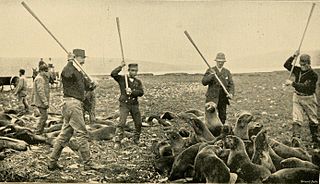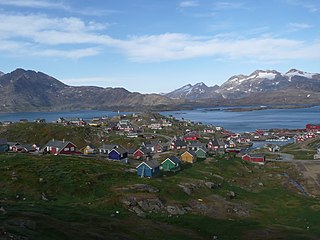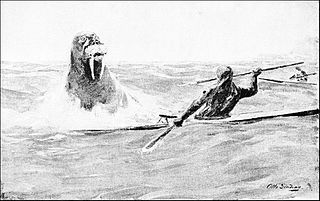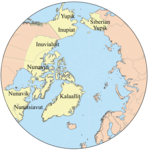Related Research Articles

A kayak is a small, narrow human-powered watercraft typically propelled by means of a long, double-bladed paddle. The word kayak originates from the Greenlandic word qajaq.

Kayaking is the use of a kayak for moving over water. It is distinguished from canoeing by the sitting position of the paddler and the number of blades on the paddle. A kayak is a low-to-the-water, canoe-like boat in which the paddler sits facing forward, legs in front, using a double-bladed paddle to pull front-to-back on one side and then the other in rotation. Most kayaks have closed decks, although sit-on-top and inflatable kayaks are growing in popularity as well.

Sedna is the goddess of the sea and marine animals in Inuit mythology, also known as the Mother of the Sea or Mistress of the Sea. The story of Sedna, which is a creation myth, describes how she came to rule over Adlivun, the Inuit underworld.
The Thule or proto-Inuit were the ancestors of all modern Inuit. They developed in coastal Alaska by the year 1000 and expanded eastward across northern Canada, reaching Greenland by the 13th century. In the process, they replaced people of the earlier Dorset culture that had previously inhabited the region. The appellation "Thule" originates from the location of Thule in northwest Greenland, facing Canada, where the archaeological remains of the people were first found at Comer's Midden.
The culture of Greenland has much in common with Greenlandic Inuit tradition, as the majority of people are descended from Inuit. Many people still go ice fishing and there are annual dog-sled races in which everyone with a team participates.

Seal hunting, or sealing, is the personal or commercial hunting of seals. Seal hunting is currently practiced in nine countries: United States, Canada, Namibia, Denmark, Iceland, Norway, Russia, Finland and Sweden. Most of the world's seal hunting takes place in Canada and Greenland.

The umiak, umialak, umiaq, umiac, oomiac, oomiak, ongiuk, or anyak is a type of open skin boat, used by both Yupik and Inuit, and was originally found in all coastal areas from Siberia to Greenland. First used in Thule times, it has traditionally been used in summer, for moving people and possessions to seasonal hunting grounds, and for hunting whales and walrus. Although the umiak was usually propelled by oars (women) or paddles (men), sails—sometimes made from seal intestines—were also used, and, in the 20th century, outboard motors. Because the umiak has no keel, the sails cannot be used for tacking.
Piblokto, also known as pibloktoq and Arctic hysteria, is a condition most commonly appearing in Inughuit societies living within the Arctic Circle. Piblokto is a culture-specific hysterical reaction in Inuit, especially women, who may perform irrational or dangerous acts, followed by amnesia for the event. Piblokto may be linked to repression of the personality of Inuit women. The condition appears most commonly in winter. It is considered to be a form of a culture-bound syndrome, although more recent studies question whether it exists at all. Piblokto is also part of the glossary of cultural bound syndromes found in the Diagnostic and Statistical Manual of Mental Disorders (DSM-IV).

Ittoqqortoormiit, formerly known as Scoresbysund, is a settlement in the Sermersooq municipality in eastern Greenland. Its population was 345 as of 2020, and it has been described as one of the most remote settlements on Earth.

A kayak roll or Eskimo roll is the act of righting a capsized kayak by use of body motion and/or a paddle. Typically this is done by lifting the torso towards the surface, flicking the hips to right the kayak, and applying a small force by means of the paddle to assist the torso back over the boat.

The Inughuit, or the Smith Sound Inuit, historically Arctic Highlanders or Polar Eskimos, are Greenlandic Inuit. They are the northernmost group of Inuit and the northernmost people in North America, living in Greenland. Inughuit make up about 1% of the population of Greenland.

Reindeer hunting in Greenland is of great importance to the Greenlandic Inuit and sports hunters, both residents and tourists. Reindeer (caribou) are an important source of meat, and harvesting them has always played an important role in the history, culture, and traditions of the Greenlandic Inuit. Controlled hunting is important for the welfare of reindeer, the quality of life for Inuit, both as food, and part of their culture and Greenlandic culture in general, and the preservation of tundra grazing areas. Therefore, scientific research is regularly performed to determine the quotas needed to maintain a proper ecological balance.

Inuit are a group of culturally and historically similar Indigenous peoples traditionally inhabiting the Arctic and subarctic regions of North America, including Greenland, Labrador, Quebec, Nunavut, the Northwest Territories, Yukon (traditionally), Alaska, and Chukotsky District of Chukotka Autonomous Okrug, Russia. Inuit languages are part of the Eskimo–Aleut languages, also known as Inuit-Yupik-Unangan, and also as Eskaleut. Inuit Sign Language is a critically endangered language isolate used in Nunavut.

Historically Inuit cuisine, which is taken here to include Greenlandic cuisine, Yup'ik cuisine and Aleut cuisine, consisted of a diet of animal source foods that were fished, hunted, and gathered locally.

Greenlandic cuisine is traditionally based on meat from marine mammals, birds, and fish, and normally contains high levels of protein. Since colonization and the arrival of international trade, the cuisine has been increasingly influenced by Danish, British, American and Canadian cuisine. During the summer when the weather is milder, meals are often eaten outdoors.

The Greenlandic Inuit are the indigenous and most populous ethnic group in Greenland. Most speak Greenlandic and consider themselves ethnically Greenlandic. People of Greenland are citizens of Denmark.

Iivit or Tunumiit are Indigenous Greenlandic Inuit from Iivi Nunaa, Tunu in the area of Kangikajik and Ammassalik, the eastern part of Inuit Nunaat. The Iivit live now mainly in Tasiilaq and Ittoqqortoormiit and are a part of the Arctic people known collectively as the Inuit. The singular for Iivit is Iik or for Tunumiit version it is Tunumiu.
A termination for medical reasons (TFMR) is an induced abortion motivated by medical indications involving the fetus or mother. In most countries, health risks are the only basis for obtaining a legal abortion. Prenatal screening can allow early diagnosis, and abortion if desired or necessary. Some medical organizations advocate the offer of diagnostic testing by chorionic villi sampling, and amniocentesis to all pregnant women, as a matter of course.

Walrus attacks are attacks inflicted upon humans, other walruses and other animals by the walrus. They have been documented in the Arctic by the Inuit and by European explorers, both on land and at sea. The Greenland Inuit refer to the red walrus as saanniartoq, "the one who turns against one".

Inuit navigation techniques are those navigation skills used for thousands of years by the Inuit, a group of culturally similar indigenous peoples who inhabit the Arctic and subarctic regions of Greenland, Canada, and Alaska. On the tundra, Inuit hunters would travel for long distances when hunting for game, and on the coastal waters, hunters would travel out of the sight of land, and they would need to orientate themselves to the location of favoured fishing or hunting places, or on the return journey to their dwelling place.
References
- 1 2 Yo Jackson (18 August 2006). Encyclopedia of Multicultural Psychology. SAGE. pp. 49–. ISBN 978-1-4129-0948-8.
- 1 2 Daniel Merkur (1992). Becoming Half Hidden: Shaminism and Initiation Among the Inuit. Taylor & Francis. pp. 254–. ISBN 978-0-8153-0783-9.
- ↑ Digest of Neurology and Psychiatry. Institute of Living. 1963.
- ↑ Sociological Abstracts. Sociological Abstracts, Incorporated. 1967.
- 1 2 3 Smutylo, A. (2014). The Memory of Water. Life Writing. Wilfrid Laurier University Press. p. 100. ISBN 978-1-55458-876-3 . Retrieved 2019-01-18.
- 1 2 Henn, F.; Sartorius, N.; Helmchen, H.; Lauter, H. (2013). Contemporary Psychiatry. Springer Berlin Heidelberg. p. 2–PA224. ISBN 978-3-642-59519-6 . Retrieved 2019-01-18.
- ↑ Fritz Henn; Norman Sartorius; Hanfried Helmchen; Hans Lauter (11 November 2013). Contemporary Psychiatry. Springer Science & Business Media. pp. 2–. ISBN 978-3-642-59519-6.
- ↑ Inter-Nord. Centre d'études arctiques de l'École pratique des hautes études. 1968.
- ↑ Nutt, D.; Ballenger, J.C.; Lepine, J.P. (1999). Panic Disorders: Clinical Diagnosis, Management and Mechanisms. Taylor & Francis. p. 1. ISBN 978-1-85317-518-3 . Retrieved 2019-01-18.
